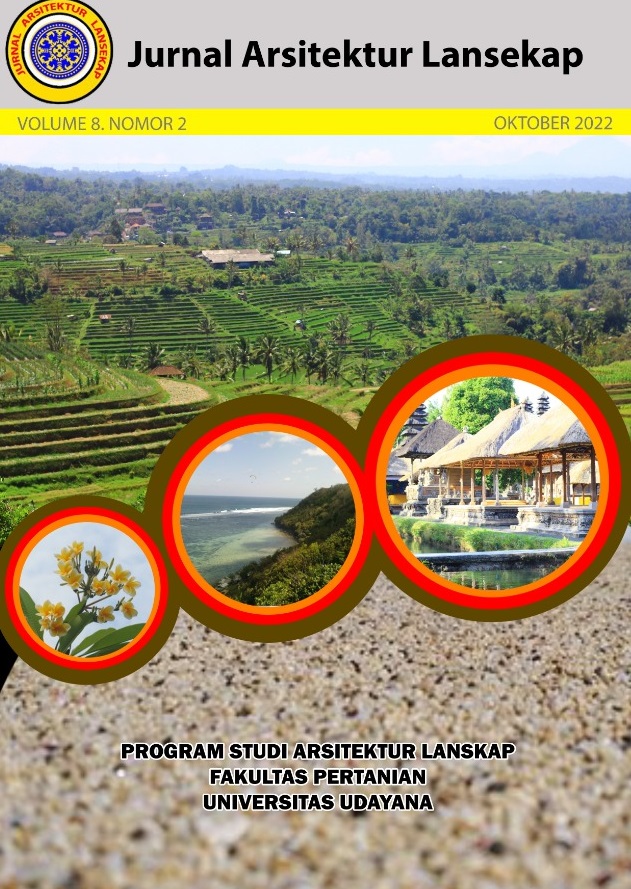Pengaruh tata elemen fisik terhadap pola aktivitas pengunjung pada Taman Lila Ulangun di sempadan Sungai Oongan Denpasar
Abstract
The river border arrangement can be used as a place for public activities, which one is the Lila Ulangun Park on the Oongan River (tukad) border, Tonja Village, Denpasar. Previously, this area was an unorganized area that it had minimal activity. With the arrangement on this river border, indirectly invites people or visitors to do activities in here. Activities that occur in Lila Ulangun Park are related to physical element settings. This study aims to identify utilization activity patterns and the influence of the physical setting at Lila Ulangun Park. This study uses descriptive qualitative methods with data collection techniques by means of literature studies, interviews and field observations. The results of this study indicate that the intensity of visitors in the classification of time units looks different where the most activity occurs in the afternoon. From the research results, it was also found that there was a relation between activity and the physical setting of the park as well as the influence of activity. Shade in the form of shady trees, gazebo, accessibility, open space, and lighting are the most influential physical elements in safety and comfort in activities with different time contexts. Researchers provide recommendations in the form of facilities such as gazebos, shade trees, and lighting at several points of the room.
Downloads
References
Dinas Pekerjaan Umum dan Penataan Ruang Kota Denpasar Bagian Pengairan. (2018). Taman Lila Ulangun. Denpasar.
Harris, C. W. & Dines, N. T. (1998). Time-saver Standards for Landscape Architecture. McGraw-Hill. New York.
Haryadi & Setiawan, B. (1995). Arsitektur Lingkungan dan Perilaku. Gadjah Mada University Press. Yogyakarta.
Haryadi & Setiawan, B. (2010). Arsitektur Lingkungan dan Perilaku. Gadjah Mada University Press. Yogyakarta.
Irawan, R. F. & Widayanti, W. (2014). Kebijakan penataan sempadan Sungai Cisadane di Kota Tangerang (Penanganan penyalah gunaan lahan di Kelurahan Babakan dan Kelurahan Mekarsari). Journal of Politic and Government Studies, 3(4):472–487.
Laurens, J. M. (2004). Arsitektur dan Perilaku Manusia. Grasindo. Jakarta.
Laurens, J. M. (2005). Arsitektur dan Perilaku Manusia. Grasindo. Jakarta.
Maryono, A. (2009). Kajian lebar sempadan sungai (Studi kasus sungai-sungai di provinsi Daerah Istimewa Yogyakarta). Dinamika TEKNIK SIPIL, 9(1):55–66.
Nasution, S. (1996). Metode Penelitian Naturalistik Kualitatif. Tarsito. Bandung.
Sommer, R. (1980). Behavior Mapping: Practical Guide to Behavior Research. Oxford University Press. New York.
Tamin, O. Z. & Frazila, R. B. (1997). Penerapan konsep interaksi tata guna lahan - sistem transportasi dalam perencanaan sistem jaringan transportasi. Jurnal Perencanaan Wilayah Dan Kata, 8(3):11–18.
Winartha, I. M. (2006). Metodologi Penelitian Sosial Ekonomi. Andi Offset. Yogyakarta.

This work is licensed under a Creative Commons Attribution-ShareAlike 4.0 International License.
An author who publishes in the Jurnal Arsitektur Lansekap (JAL) agrees to the following terms:
- Author retains the copyright and grants the journal the right of first publication of the work simultaneously licensed under the Creative Commons Attribution-ShareAlike 4.0 License that allows others to share the work with an acknowledgement of the work's authorship and initial publication in this journal
- Author is able to enter into separate, additional contractual arrangements for the non-exclusive distribution of the journal's published version of the work (e.g., post it to an institutional repository or publish it in a book) with the acknowledgement of its initial publication in this journal.
- Author is permitted and encouraged to post his/her work online (e.g., in institutional repositories or on their website) prior to and during the submission process, as it can lead to productive exchanges, as well as earlier and greater citation of the published work (See The Effect of Open Access).
Read more about the Creative Commons Attribution-ShareAlike 4.0 Licence here: https://creativecommons.org/licenses/by-sa/4.0/.







